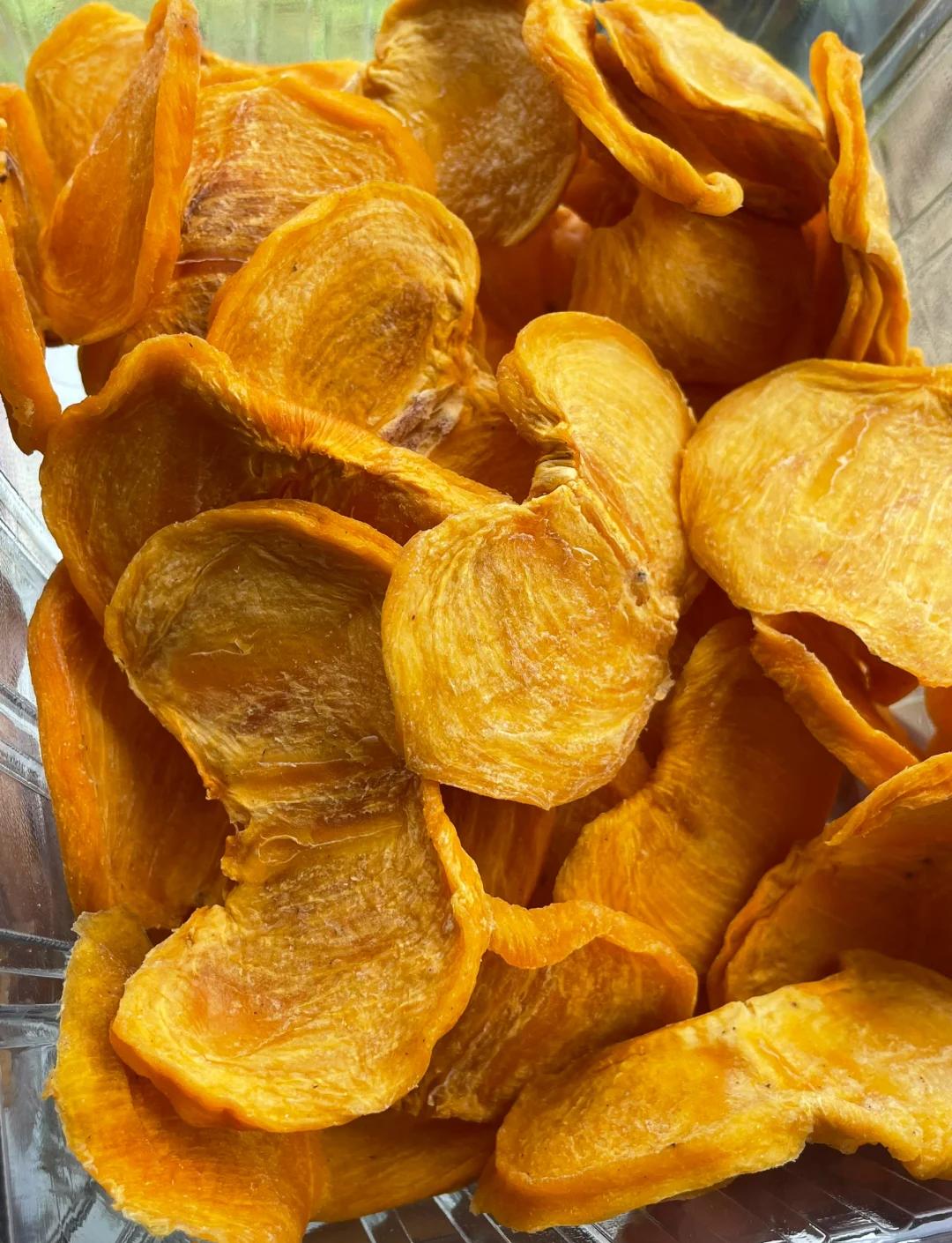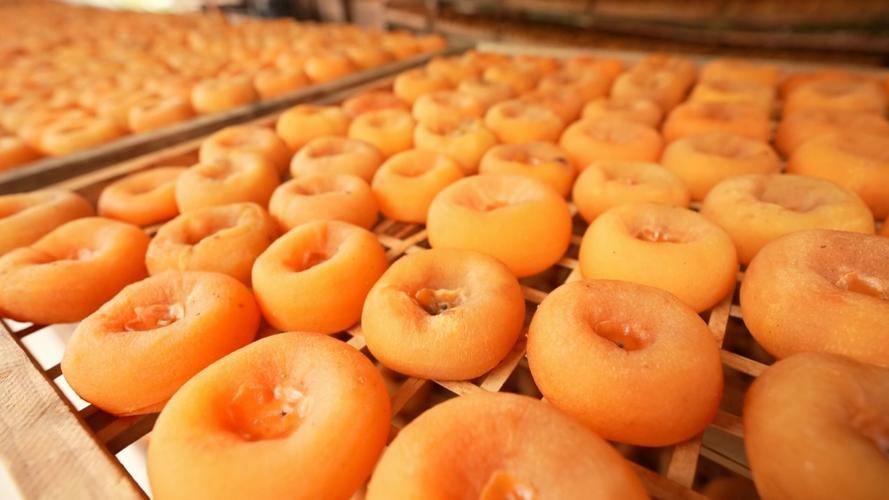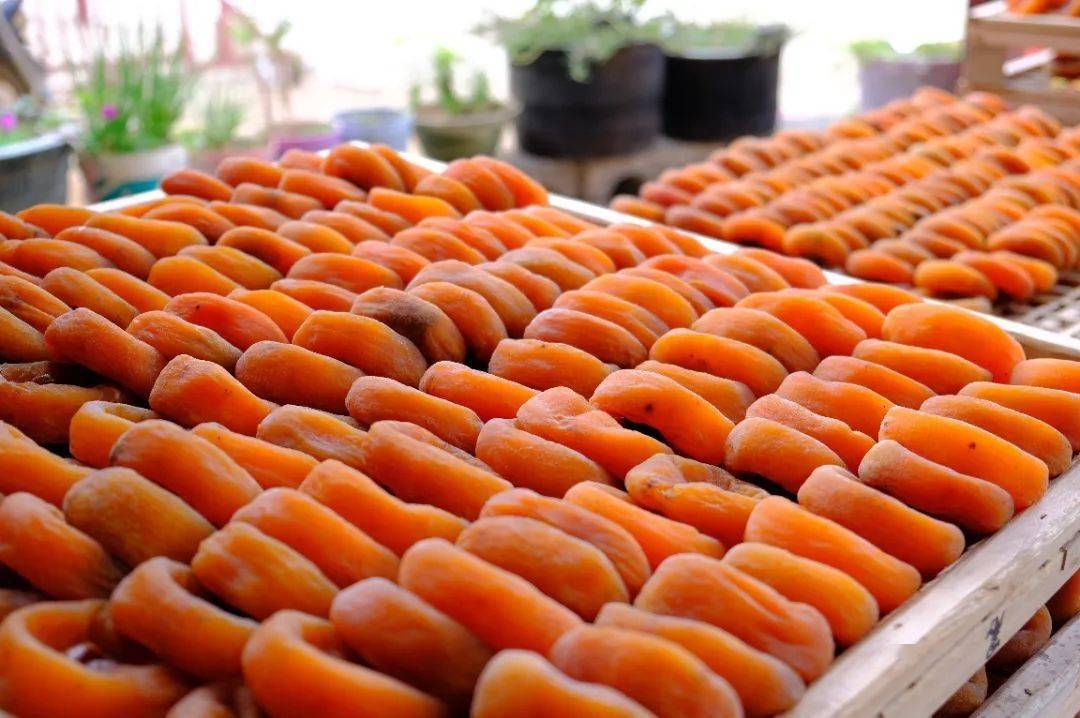I. Raw material selection and pretreatment
1. Raw material selection
Varieties: Choose varieties with firm flesh, high sugar content (≥14%), regular fruit shape, and no pests and diseases.
Maturity: Eighty percent ripeness is appropriate, the fruit is orange-yellow, and the flesh is firm. Overripe or raw persimmons will affect the quality after drying.
Screening: Remove rotten fruits, deformed fruits, and fruits with mechanical damage.
2. Cleaning and peeling
Cleaning: Add 0.5% dilute hydrochloric acid to soak for 5-10 minutes to enhance the cleaning effect, and then rinse with clean water.
Peeling: Use manual peeling or mechanical peeling machine to remove the peel. If it is not processed immediately after peeling, it can be soaked in a mixture of 0.5% salt and 0.1% citric acid to prevent oxidation and browning.
3. Cutting and stem removal
Cutting: Cut the persimmon into slices with a thickness of about 0.5-1 cm. If you want to make whole dried fruit, you can skip the cutting step, but you need to make a small cross cut at the stem to facilitate water evaporation.
Stalk removal: Use a knife to remove the stem and calyx of the persimmon to ensure a smooth cut surface.
II. Color protection and hardening treatment (optional step)
1. Color protection treatment
Blanching: Put the persimmon in hot water at 80-90℃ for 2-3 minutes to destroy the oxidase activity in the pulp and prevent browning during the drying process. After blanching, quickly cool to room temperature with cold water.
Sulfur treatment: If long-term storage is required, sulfur fumigation can be used to protect the color. Place the persimmons in a sulfur fumigation room, use 300-500 grams of sulfur for every 100 kilograms of raw materials, ignite the sulfur and seal it for 4-6 hours. It should be noted that the sulfur residue must meet food safety standards (≤50mg/kg).
2. Hardening treatment
For varieties with softer flesh, persimmons can be soaked in 0.1%-0.2% calcium chloride solution for 1-2 hours to harden the pulp tissue and avoid deformation or rot during drying. Rinse with clean water after treatment.
III. Preparation before drying
1. Plating and laying
Place the processed persimmons evenly on the baking tray or wire rack, 1-2 cm apart from each other, avoid stacking, ensure good ventilation and uniform water evaporation. When drying the whole fruit, place the fruit stem upward to facilitate water discharge.
The baking tray can be made of stainless steel, bamboo or food-grade plastic, and needs to be disinfected before use (such as wiping with 75% alcohol) to prevent contamination.
2. Pre-drying (natural drying)
If conditions permit, persimmons can be pre-dried in the sun for 1-2 days to evaporate the surface moisture and reduce the drying time. During pre-drying, it is necessary to cover with gauze to prevent mosquito bites and dust pollution, and turn it over 1-2 times a day to ensure uniform drying.
IV. Drying process control (key links)
1. Selection of drying equipment
The Western Flag drying equipment adopts PLC intelligent control and precise temperature control; the heat source range is wide, such as electricity, heat pump, steam, hot water, thermal oil, natural gas, LPG, diesel, biogas, biomass pellets, firewood, coal, etc.; according to the yield of persimmons, you can choose a drying room or a belt dryer.
The following is a reference for the drying process of the drying room
2. Drying process parameters
Stage 1: Preheating (0-2 hours)
Temperature: gradually increase from 30℃ to 45℃, humidity is controlled at 60%-70%, and wind speed is 1-2 m/s.
Purpose: to evenly increase the internal temperature of persimmons and activate the migration of moisture to the surface.
Stage 2: Constant drying (2-10 hours)
Temperature: 45-55℃, humidity reduced to 40%-50%, wind speed 2-3 m/s.
Operation: Turn the material over every 2 hours to ensure uniform heating. A large amount of water evaporates at this stage, and the weight of persimmons is reduced by about 50%.
Stage 3: Slow-down drying (10-20 hours)
Temperature: gradually rise to 60-65℃, humidity controlled below 30%, wind speed 1-2 m/s.
Purpose: Reduce the evaporation rate of surface moisture, prevent the surface of persimmons from crusting, and promote the slow diffusion of internal moisture outward.
Stage 4: Cooling balance (after 20 hours)
Temperature: drop below 40℃, turn off the heating system, keep ventilation, and make the internal moisture of persimmons evenly distributed.
End point judgment: The moisture content of dried persimmons should be controlled at 15%-20%. The flesh should be elastic and not sticky when squeezed by hand, and no juice should seep out after cutting.
3. Precautions
During the drying process, the temperature and humidity should be monitored in real time to avoid excessive temperature causing the persimmons to burn or lose nutrients (vitamin C loss is significant when it exceeds 70℃).
The drying time of persimmons of different varieties and cutting methods is different, and the process parameters need to be adjusted flexibly. For example, the drying time of whole fruit is usually 5-10 hours longer than that of sliced fruit.
V. Softening and grading
1. Softening treatment
Put the dried persimmons in a sealed container or plastic bag and stack them for 1-2 days to redistribute the moisture in the flesh, make the texture soft and uniform, and avoid cracking or hardness.
2. Grading and screening
Grading by size, color and shape:
First-class products: complete shape, uniform color (orange-red or dark yellow), no damage, mildew and impurities, high sugar content.
Secondary products: Slight deformation is allowed, the color is slightly lighter, and there are no serious defects.
Remove discolored, broken or odorous unqualified products.
VI. Common problems and solutions
Severe browning Improper color protection or low drying temperature Strengthen color protection (such as increasing blanching temperature or extending sulfur fumigation time), control the initial drying temperature ≥45℃
Surface crusting The initial drying temperature is too high Lower the initial temperature, increase ventilation, and avoid rapid evaporation of moisture
Internal mildew Too high water content or humid storage environment Ensure that the water content is ≤20% after drying, control humidity during storage, and add desiccant if necessary
Too hard taste The drying temperature is too high or the time is too long Adjust the drying parameters, shorten the high temperature stage time, and fully soften
Post time: Jul-02-2025


















